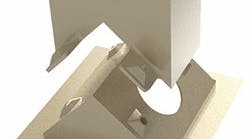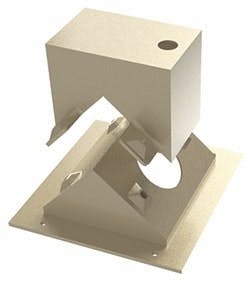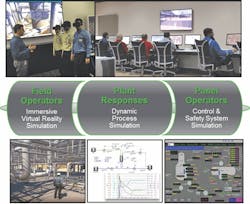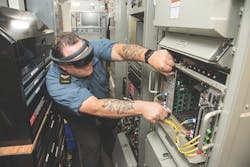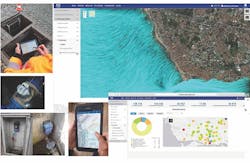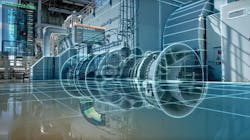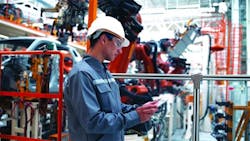Face the future: How 6 companies are using revolutionary technologies to accelerate business value
Every new best practice begins somewhere. Revolutionary technologies require bold users willing to give them a chance despite the risks of failure.
In order to determine where industry stands on some of the hottest new developments, we looked at companies who have taken leadership roles in testing the business value and sharing the results. The six include:
- A commuter rail agency using 3D printing to produce strategic maintenance spares;
- A refinery using immersive augmented and virtual reality (AR/VR) technologies for training and competence assessments;
- A naval force using 3D mixed reality (MR) technology to guide marine technicians through vessel repairs and maintenance;
- A water utility using digital twins and machine learning (ML) for water system analytics and forecasting;
- An industrial services provider using digital twins and ML to improve asset monitoring and diagnostics; and,
- An automaker using edge computing and ML to enhance weld quality.
Though these technologies are still relatively new, they have already created a lasting impression for these early adopters, most of whose goals and outcomes were presented at the ARC Industry Forum 2020 in Orlando.
3D printing of parts
The Massachusetts Bay Transit Authority is 3D printing selected maintenance spares at its Railroad Operations Division to help keep its rolling stock in service and moving passengers. “A lot of rail and public transit runs equipment that is 30-50 years old. MBTA is using 3D printing to produce parts that they can’t get anymore,” says Aaron Hurd, consulting senior manager at Blueprint, a 3D printing consultancy.
During a five-week pilot program, MBTA worked with Blueprint to identify and trial four use cases. One was a safety-critical light housing for emergency evacuation path lighting. Fabricating the part would cost a couple thousand dollars and, what’s worse, require 12 weeks lead time, observes Hurd. Since the train could not operate without the part, it would have to sit in the maintenance yard for an extended period instead of transporting commuters.
With in-house 3D printing, the housing was replicated in a couple of days and the equipment returned to service much faster. Moreover, the materials met the special flame, smoke, and toxicity requirements specific to rail.
Now, MBTA personnel are finding additional use cases on their own based on train maintenance needs. If a required part is not in the warehouse, they are looking at 3D printing as a production option (see Figure 1).
“Having the capability to produce critical components that may be considered obsolete from the vendor supply chains, out of appropriate and sometimes superior material, has really allowed us to maximize our fleet availability in order to keep up with the demands of service,” says Ryan Coholan, chief railroad officer at MTBA.
“The MBTA’s Railroad Operations Division has embraced the resiliency as well as flexibility that on-site 3D printing has presented,” Coholan says.
MBTA’s pilot of the four use cases:
- Demonstrated up to 90% cost savings per part
- Reduced lead times by 14 weeks, returning the coach to service earlier, saving $1.4 million
- Avoided $100K+ in tooling expenses.
Immersive AR/VR training
Reliance Industries Limited, India’s largest private-sector company, is using immersive AR/VR technology at its Jamnagar refinery for training and assessments. The initiative originated with the chairman’s challenge to rapidly build and drive a world-class competence development and assurance approach. RIL recently completed a year-long pilot demonstration and now a scale-up project is beginning for rollout throughout the Jamnagar super site (see Figure 2).
RIL chose the XR Studio (formerly EYESIM) AR/VR Immersive Training System (ITS) from AVEVA following a site visit where attendees saw it in action. “There was an operator training simulator in one room, immersive training in the other room, and they were simulating a coal gasification system. Any moves you made in 2D on the screens were showing in 3D in the other room,” says Mat Malladi, president of corporate business development for Reliance Industries Limited. “We saw there was something there that we could take and build upon.”
Establishing the ITS platform included determining how to future-proof the architecture, how the system worked, how it would interface with all the different devices, and how to take and interface the data according to the application, explains Malladi. Training scenarios were defined for standard operating procedures (SOP), standard maintenance procedures (SMP), and other routine and non-routine tasks.
“Once an organization gives a tool like this to their users, adoption typically is organic and fast,” says Ian Willetts, vice president of process and simulation at AVEVA. “If the AR/VR application is well designed and easy to use, with clearly defined outcomes and objectives to quantify its value, adoption happens quickly for frontline personnel and is used for various purposes across the organization.”
RIL’s ITS demonstration pilot:
- Operated for 12 months
- Was demonstrated to 300 end users and visiting dignitaries
- Included routine and non-routine scenarios for individuals and teams with active communication
- Received extremely positive overall feedback.
3D mixed reality at sea
The Royal Canadian Navy, or RCN, is using industrial mixed reality (MR) technologies to guide its remote technicians through complex repair and maintenance tasks. The 3D holographic remote support system provides sailors with a new and innovative way to approach equipment maintenance aboard active Navy vessels and maintenance bays, helping to ensure a high level of readiness (see Figure 3).
RCN’s initial proof of concept (PoC) for the RemoteSpark Mixed Reality Remote Assistant Support (MIRRAS) system from Kognitiv Spark was focused on ensuring the technology was mature enough for initial use and that the premise was valid. The next phase will greatly increase the scale of the deployment. It has been framed as a focused rollout for specific marine technicians on specific tasks and includes an extended suite of capabilities including the use of the Microsoft HoloLens 2, says Duncan McSporran, co-founder and COO of Kognitiv Spark.
“Innovation and technological advancement are critical to the future of the Royal Canadian Navy,” says RAdm Casper Donovan, Director General Future Ship Capability, Royal Canadian Navy. “We are continually seeking new ways to leverage emerging technologies in order to enhance our performance alongside and at sea.”
“At the core of overcoming challenges to adopting MR has been RCN’s approach of including the marine technicians from the earliest stage. They identified many of the workarounds to the roadblocks and numerous use cases for the capability,” says McSporran. He adds, in the words of a former Commander of the Royal Canadian Navy, “This is the level of technology that our sailors already expect to see us using, not clipboards and pens.”
RCN’s MR knowledge transfer includes:
- Live guidance, which is particularly beneficial for less-experienced technicians
- Task-supporting holographic assets, advantageous for more-experienced users.
Digital twins / ML for operations and maintenance
Águas do Porto, the water utility serving the second largest city of Portugal, is applying digital twins with ML for water system maintenance and operational improvements. H2Porto is the platform that is enabling integrated management of the coastal community’s urban water cycle. It provides current-state and historical insights from network sensor data and future-state simulations from numerical analysis, helping the utility to prevent asset failures and improve operational performance.
H2Porto leverages digital twin technology from Bentley Systems to deliver integrated digital representations of all water systems of the city to an operational dashboard, where the modeling and simulations are performed (see Figure 4). Predictive analysis of Porto’s water system allows Águas do Porto to forecast future issues such as pipe bursts, valve and pump shut-downs, flooding, and water quality degradation and take appropriate action.
“The analysis of the network sensors, together with the analysis of the predictive models, helps us to understand the future behavior of our water assets, based on data,” explains Pedro Vieira, IT and innovation director at Águas do Porto. “For example, we have a model where, through an algorithm, it is possible to predict leaks in pipelines based on historical data from operations, weather, and assets. We’re also developing a model that is optimizing field operational teams that deliver water meters.”
Águas do Porto is currently working on enhancing the tools they already have with more sensors and more functionalities. “We want to increase the coverage of our models, starting with wastewater and, later, stormwater,” says Vieira. “At the moment, water network sensors are linked to the models, but our goal is to also integrate sensors associated with customers’ water consumption.”
With Águas do Porto’s H2Porto:
- Water supply interruptions fell 42.9%
- Volume of non-revenue water dropped by 10.1%
- Duration of pipe burst repairs improved 6%
- Number of sewer collapses decreased 14.7%
- Duration of sewer and service connection repairs improved 44.5%.
Digital twins / ML for predictive maintenance
GE Digital Industrial Managed Services (IMS) uses digital twins and ML models for remote asset monitoring, diagnostics, and proactive maintenance of its customers’ industrial internet of things (IIoT) deployments.
IMS helps companies in industries such as oil and gas, manufacturing, utilities, and aviation avoid unplanned downtime of critical machines using digital twin blueprints for predictive analytics (see Figure 5). It currently has a library of over 300 OEM-agnostic digital twin blueprints.
“Ultimately, we’re helping customers move from corrective maintenance to predictive maintenance, and to having their strategies defined and optimized in real time,” says Chad Stoecker, global vice president of industrial managed services at GE Digital.
ML models provide early warning of failure. By contrast, reacting to a hard alarm limit may be too late to avoid costly secondary or tertiary effects. “With ML, actions can start when the signals deviate from the model instead of waiting for the hard alarm, giving maintenance organizations more time for more economical planning to mitigate the failure,” Stoecker explains.
Automating data processing is essential in the digital era. “I always tell customers, if you have good people looking at good data, that’s a waste of time because you need all of your people analyzing problems and coming up with solutions,” says Stoecker. “Where ML works really well is to pre-filter through all that data, identify causes early, suggest diagnoses, and serve up the information to make your reliability engineers more effective.”
In 2019, GE Digital IMS:
- Helped customers manage more than 8,000 assets
- Helped generate $187 million of customer-documented savings.
Edge analytics with Machine Learning
Audi is using edge analytics and ML to detect faulty welds in vehicles made at its production plant in Neckarsulm, Germany. What started as a PoC to improve quality control for spot welding is now being extended to other use cases at the Neckarsulm site, and potentially across all Volkswagen Group production plants.
Autonomous robots using welding guns make about 10,000 welds per car at the body shop. Previously, a team of 32 engineers with clipboards and ultrasound probes would perform weld quality inspections on one sample vehicle each day. Now, using artificial intelligence (AI) and Intel technology, weld inspection data is automatically ingested from the welding gun controllers for analysis.
An ML algorithm was created and trained to detect faulty welds by comparing generated predictions to known good configurations characterized by actual inspection data. It enables data-driven predictive analytics on the edge, at the weld controller, with AI techniques. Technicians are alerted when faulty welds are detected, and also apprised of potential configuration changes to mitigate or eliminate faults and for cars with a higher number of faulty welds (see Figure 6).
“This proof of concept was very successful – we’ve shown that it can work. What we are doing now is taking it out of the production lab and out of the PoC stage” and making it available to other Volkswagen Group factories, says Henning Löser, head of the Audi Production Lab. “And this is the way things should work. You had the idea; you had the business value (I can save on quality and inspection); you have the algorithm that’s working; and now, you scale it out in order to harvest on the business value.”
Audi Neckarsulm highlights:
- 900 vehicles assembled per day
- 10+ million spot welds created per day
- 10,000 welds (1 vehicle) inspected manually each day before ML
- 100% of welds can be inspected automatically with high accuracy using ML
- Reduction in labor costs using predictive welding inspections.
Positive outcomes
Early adopters such as the six above are not only accelerating business value internally, but they are helping to establish a business case that will benefit the broader industry. Their foundational efforts could potentially help others to justify skipping the PoC phase and move directly into practical applications of the innovative technology.
